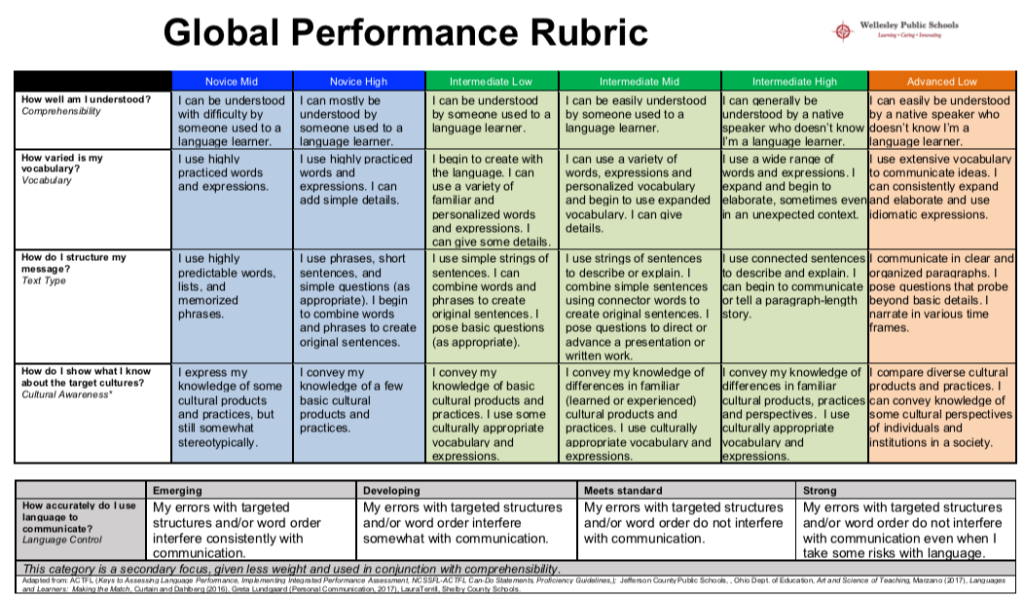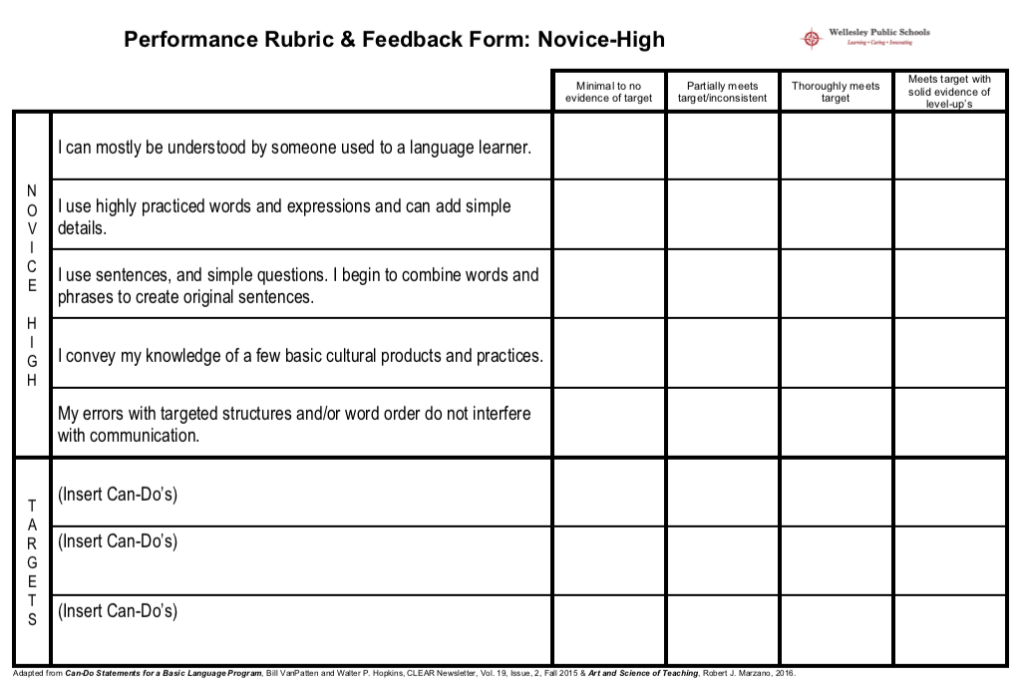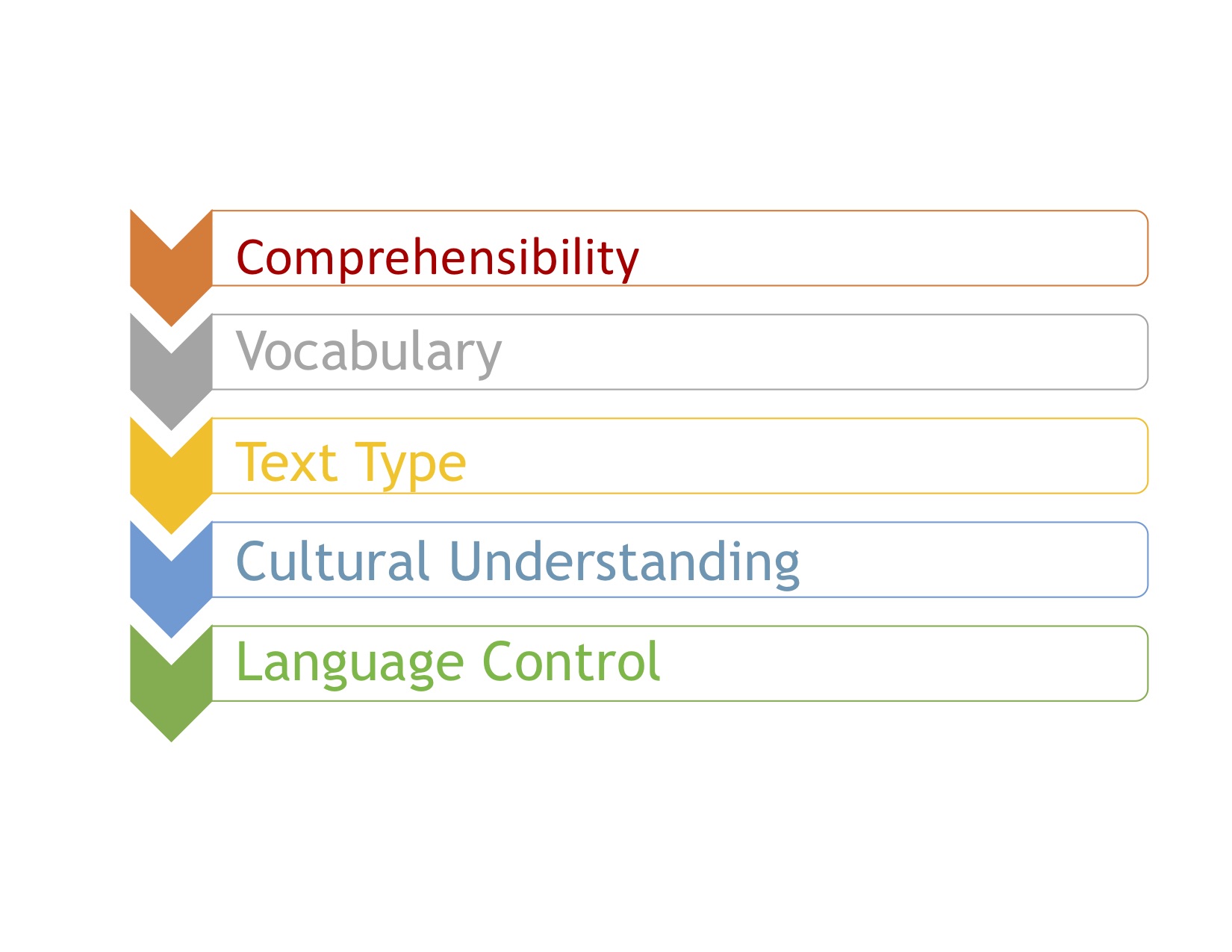Back in September 2017, we’d just adopted our newly-revised performance feedback form/rubric for our program. Eight teachers had worked that summer for many hours to create it. (See my 2017 post, I’ve never met a rubric I liked to read about that journey and my prediction for where we’d be a year later).
We began that school year on a mission—to use the rubric as a tool to help us calibrate our standards, to help students have a clear picture of those standards, and to help them move up on the proficiency ladder. In practice, the rubric still seemed clunky and uncomfortable for most of us —which had been the problem motivating us to redesign it in the first place. My response options were exasperation or perseverance. I chose perseverance (Well, OK, maybe, possibly, probably, I chose exasperation too at some points in the year).
We had to figure out what the trouble was. Why was it so challenging for teachers to hold student work up against the performance targets we’d so carefully described and to give them feedback on their work? Why was it so hard to assign a grade to that work? One of the challenges teachers reported was distinguishing between sub levels. What really was the difference between novice-high work and intermediate-low work on a single writing prompt? Did we even have enough information or expertise to make that distinction? Teachers were begging me to figure something out. If we really intended the rubric to be a tool for teachers to give meaningful feedback to students, what we had in place wasn’t really the answer —yet.
In 2015, I learned about the idea of a single-point rubric from one of my favorite educational podcasts, Cult of Pedagogy. —If you haven’t heard it, consider dropping everything you’re doing right now to give a listen— I loved the idea, but I knew that the rubric we had at that time was not long for this world, that we needed to do some reading and educate ourselves on rubrics, feedback and assessment in general first, and the single-point idea seemed like i+10 and not i+1 for my teachers. So, I waited.
Not quite a year into using our newly-minted rubric (AKA feedback form), after we’d played around with ways to use it better as a teaching & learning tool, and teachers were asking for help, I knew I could start talking “single-point” with a small group of them (with a plan to divide and conquer later on). I’d been convinced from my reading that a single-point rubric can be a really powerful tool for effective teaching and learning. As Jennifer González, the host of Cult of Pedagogy, points out about single-point rubrics:
Teachers find them easier and faster to create, because they no longer have to spend precious time thinking up all the different ways students could fail to meet expectations.
Students find them easier to read when preparing an assignment. With only the target expectations to focus on, they are more likely to read those expectations.
They allow for higher-quality feedback, because teachers must specify key problem areas and notable areas of excellence for that particular student, rather than choosing from a list of generic descriptions. https://www.cultofpedagogy.com/single-point-rubric/
Who can argue with that?! So, I took our rubric/feedback form and created single-point rubrics for each course and performance level, Novice-Mid to Advanced-Low. My design was inspired largely by Can-Do Statements for a Basic Language Program By Bill VanPatten and Walter P. Hopkins and Robert Marzano’s learning goal scale (See Art & Science of Teaching and Designing & Teaching Learning Goals & Objectives by Robert Marzano). The design is simple: the proficiency level (i.e., performance target) along with the learning targets (i.e., can-do statements) make up the criteria for the single point.


Now, I have had debates with some people whom I respect tremendously in the language teaching world (and who have guided and mentored me over several years) about single-point rubrics. One person made the argument that the single-point rubric was problematic because students need to see the full range of proficiency from Novice to Advanced. I don’t disagree. Students do indeed need that full context view of proficiency, and they see it in the global rubric, can describe the performance target for their current course, and reflect on their learning systematically, with an eye towards leveling up.
To my thinking, the single-point rubric gives teachers a structure to provide students with specific, descriptive, actionable feedback connected to learning targets and allows for seamless tiered instruction. We use the terms Glow and Grow (thanks to Stephanie Carbonneau from Maine (@MmeCarbonneau on Twitter) via Mike Travers in my department (@Travers_Tweets on Twitter) to give feedback and for students to reflect and describe their next steps and strategies for leveling up. Doug Reeves describes an effective feedback loop as feedback which leads to hard work, which in turn leads to improved performance and success. I think it’s a particularly helpful tool for students who have more trouble self-regulating.
- Task requirements are clearly defined (not just the proficiency target level).
- Goal setting —either because the student’s work hasn’t met the standard, or because the work meets or exceeds the standard—is easy to navigate because you have both proficiency target level task-specific language functions and task-specific (inter-)cultural understandings. (Think of Leslie Grahn and tiering tasks.)
- You have built-in strategy instruction tool for students who need that scaffolding.
I think that moving from the somewhat unwieldy global rubric to a single-point feedback form has been a game-changer for students and teachers. I’ve seen it in action in the classroom and it truly warms my heart.
I’d love to hear your thoughts on single-point rubrics. If you’re interested in some further reading, check out some of these:
Ahead of the Curve: The Power Of Assessment To Transform Teaching And Learning, Douglas Reeves
Classroom Assessment and Grading That Work, Robert J. Marzano
Elements of Grading: A Guide to Effective Practice, Douglas Reeves
Enacting the Work of Language Instruction, Eileen W. Glisan And Richard Donato
How to Give Effective Feedback to Your Students, 2nd Edition, Susan M. Brookhart
Implementing Integrated Performance Assessments, Bonnie Adair-Hauk, Eileen W. Glisan, Francis J. Troyan
Making Communicative Language Teaching Happen, Lee And Vanpatten
Teacher’s Handbook: Contextualized Language Instruction, Judith L. Shrum & Eileen W. Glisan
Transforming Classroom Grading, Robert J. Marzano
The Keys to Assessing Language Performance, Paul Sandrock
